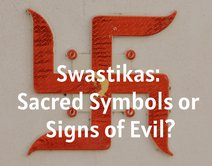The sun cross, sun wheels, and the fylfot are a few names for the ancient symbol that is more commonly known as the swastika. Find out the complex history of the symbol, what it has meant throughout history to many different people, and whether it is a symbol of hate that should be discarded, or it is an image of sacred spirituality to be cherished.
Throughout history, people have always used symbols to convey meaning, but few symbols are as easily recognized as the swastika. From India, to ancient Greece, and even Russia, the swastika, and earlier forms of it have been around since prehistoric times. In more recent times, it became a symbol of terror in one part of the world, and has been resurrected by controversial groups to represent their hatred of people who are different from them. Join Mysticsense to explore the complex history of the swastika from its form as a sun wheel to today’s use of it by people around the world. Some people say it should be discarded because of it’s use by hate groups, but is it too sacred to discard? Read on to find out.
What is a Swastika?

A swastika is a symbol that has been used in various cultures around the world from prehistory to modern times, and it is a very controversial symbol. It is generally accepted that the swastika takes the form of a cross, and sometimes the symbol is completely closed but the most recognizable forms of swastikas have open edges forming almost a pinwheel type of shape. It is believed by some to have evolved from the sun cross, and has been found in the Germanic world, Africa, multiple other locations throughout Europe, Mesopotamia, in both North and South America, in many parts of Asia, and even in Greece.
Early forms of it are as simple as a cross within a circle, and some are circles with up to 12 spokes within them. Some people believe that early forms of it represented a chariot wheel, and others say that it represented the blazing sun. It has been found painted in temples, as adornment for jewelry, on devotional items found within places of worship, and on images of ancient gods and goddesses. It has been found on rock carvings, in Bronze Age burial mounds, and may have been used to represent solar calendars or solar eclipses. Read about the sunrise and sunset in folklore here: Sunset and Sunrise Meaning in Magic and Folklore
What Does a Swastika Symbolize?
There is not one unified meaning for the swastika, because so many different people have used it for so many different centuries. However, five different groups of people will be discussed. Ancient and modern Hindus have held the swastika sacred for generations. Both North and South American indigenous people have revered the swastika. Buddhists too, have held the swastika sacred. Ancient people in multiple parts of Europe had swastikas, and perhaps most famously Nazis reinvented the swastika to serve their own nefarious purposes.
Hindu
Hindus have been using the swastika at least as early as 4,000 BCE, maybe earlier. To Hindus, the swastika is a symbol of good fortune and is regularly put on their cars, in temples, in their homes and businesses, and in ashrams. The threshold of the front of some of their homes will be adorned with swastikas and during Diwali. A lot of people will wash away old swastikas and reapply them. 2008, the second Hindu Jewish leadership summit stated “ The swastika is an ancient and greatly auspicious symbol of the Hindu tradition. It is inscribed on Hindu temples, ritual altars, entrances, and even account books.”
The four limbs of the swastika can mean different things. For some people they represent the four Vedas including the Rig Veda, the Yajur Vida, the Sama Vida, and the Atharva. Together this forms foundational Hindu teachings. To others they represent the four stages of life including youth as a student, the age of the householder, retirement, and older age. To some they represent the four seasons, the four directions, and something called the four yugas which are the edges of time. They can represent four noble goals to have in life including Dharma for spiritual conduct, Artha to pursue prosperity, Kama to pursue pleasure in life, and Moksha, which is spiritual liberation. Read about discovering the meaning of life here: What is the Meaning of Life
Ancient American
Some southwestern Native American tribes have been using the swastika symbol for generations and it is often used in healing rituals and to create sacred sand paintings. For the Navajo, it represents good luck and the cycle of life itself. For them, it represents something called the whirling log which is the movement of the earth. To the Hopi it represented their nomadic clans. Not called the swastika by them, of course, this symbol represents healing and their ancestors. It has even been said there were swastikas in ancient Aztec artwork.
Buddhist
To the Buddhists, the swastika is known as “manji” and it is a symbol of prosperity, universal harmony, good luck, long life, abundance, and some other wonderful things. To some, it represents eternity. It is believed that there are 65 special symbols that are on the footprint of the Buddha and it is believed the swastika is the first symbol. The symbol can also be found on the feet, chest, palms, and the body of the Buddha. The swastika is called “The Seal on Buddha's Heart.“ The swastika is used to identify Buddhist temples. It also represents the Dharma Wheel which represents The Eight Fold Path and the completeness of the Dharma, or the Buddhist teachings.
Ancient European

The swastika is believed to be one of the oldest used symbols in general and in parts of Europe it dates back to at least 10,000 BCE in Ukraine. The symbol known as the Mezine swastika depicts a female bird and was carved on some mammoth ivory tusks. It was found with some phallic shaped objects and some experts believe that that means the swastika was a fertility symbol to those people. Individual swastikas appeared during the Neolithic Vinca culture which was in southeastern Europe close to 7,000 years ago. During the Bronze Age, swastikas became more popular. During World War II, when the Nazis occupied Kiev, they were fascinated with 4,000 year old pots with swastikas on them and believed that it was evidence of ancient Aryans they believed they shared ancestry with.
Russia also used the swastika in ancient times. A 12th century AD a dress collar has been found that belonged to a princess and it was decorated with the swastika. Fragments from the 7th century BCE from Greece show swastikas. Another form of the swastika known as the solar cross can be found all over Europe and is believed to have been a very large part of prehistoric religion. Swastika pins, and pendants found in the second Millennium BCE in Switzerland we're made of bronze. It is believed that they represented the sun itself. Let's Christianity made it to the British Isles, the form of the sun cross known as the Celtic Cross took hold and can be found to have been made as early as the 9th century. Read more about ancient swastika artifacts here: How the world loved the swastika - until Hitler stole it - BBC News
Nazis
The Nazi movement was active between 1933 and 1945 in Germany. Very soon after they arose to power Adolf Hitler became dictator of that nation and he and his party created a version of the swastika. To them, they wanted to empower themselves as they believed they were the superior race and that they shared common ancestry with people from India. They called themselves Aryans. They branded multiple different groups of people as undesirables including Slavs, the Romani, Jews, liberals, members of other political parties, Freemasons, members of various religions, and homosexuals.
They used forced labor, mass murder, and genocide to implement their radical policies. The swastika wasn't the only symbol that they used though they adapted multiple ancient Germanic rune symbols to represent their regime, but the swastika was their manin emblem. However, their sense of community included atrocities against humanity and financially they benefited greatly from this because they stole things from the people who they victimized. As a result of this rule of terror, many people have an instant aversion when they see a swastika, even when it is a non-Nazi swastika. Read about the ancient runes, symbols that endured despite Nazi terrors here: What Are Rune Stones and How to Use Them
Who Had the Swastika First?
We have no idea who used an aspect of the swastika first, but we do know where the word itself comes from- India. The word comes from the Sanskrit word svastika, which means” conducive to well-being”. It symbolizes the sun, prosperity, and good luck when it's pointing clockwise, and the word to symbolize the sun is surya. When it is turned counterclockwise, it is called sauvastika, and symbolizes the tantric aspects of the goddess Kali and the night. The earliest use of that word itself comes from The Astadhyayo, from around the year 350 BCE. It was in a passage used to explain Sanskrit grammar rules. It is possibly a much older word than that, but that is the first documentation that we currently have of it. Read about your Sun, Moon, and Rising Signs here: What’s My Sun, Moon, and Rising Sign?
The truth about sacred symbols is, they typically evolve over time and change. So the way that the swastika looks now possibly isn't exactly how it looked in 350 BCE. Why does this happen? People change things over time. They add things to their traditions, and they take things away and replace them with things that they think are better. Artists use their own distinct style, and people adapt what they like better. Remember, sacred symbols represent concepts. However, in essence, they are inanimate objects and have no meaning or power unless we attach it to them.
We may never know where the first swastika came from. We also might never know which people got the idea from other people. Because of trade routes, different ancient cultures of people had access to one another's art, culture, literature, and religions. It is possible that one culture of people created the swastika, and other people adopted the symbol from them. It is also entirely possible, especially given the fact that each culture of people has a swastika or a solar wheel that looks entirely different from anyone else's, that all people developed their swastika symbolism independently of one another, and the similarity in the shapes is a complete coincidence. Read about another powerful symbol, the four leaf clover here: What does a Four Leaf Cover Mean? Explained
Should the Swastika Be Discarded?

Some people say the swastika should be thrown out entirely because of German Nazis and hate groups today. They say it could trigger a victim of Nazi atrocities and nobody has the right to risk upsetting a victim. They also say if you use a swastika in any form, you automatically align yourself with hate groups. What about Navajos and Hindus who use the symbol? Some people answer that it’s okay to use the symbol as long as you’re not white. What about some devotees of ancient European gods who use the symbol in the form it was in centuries ago refuse to let go of their sacred symbol? Hate groups can’t be deterred, and use of a symbol may be the last of our worries when it comes to what kind of things those people do.
So, for the time being, the swastika in the many forms it takes today is here to stay. Maybe that is a good thing, though. Each group of people who use the swastika have a specific way they use it, and each group’s swastika looks different. People easily identify their beliefs through their swastika. You can tell if someone is a Navajo using the swastika, and their swastika looks nothing like the Hindu swastika. Nobody else’s swastika looks like a hate group member’s swastika. It’s convenient to know if someone belongs to a hate group, because you will know to steer clear of them and it helps keep you safer. Read about protecting yourself by attracting positive energy and blocking negative energy here: Converting Negative Energy into Positive Energy
Symbols are inanimate objects yes, but they hold power because of what they represent. A symbol, be it a swastika or any other symbol won’t do anything to you. The person who wields it will. People easily identify themselves and what they stand for with their symbols. Maybe getting rid of a symbol isn’t the answer to hate group crimes against humanity and stopping the crimes against humanity is. Taking a symbol from people who have nothing to do with hate groups won’t solve anything. You can find out how to stand against hate groups here: Ten Ways to Fight Hate: A Community Response Guide | Southern Poverty Law Center (splcenter.org)
Eternal life, good luck, and the power of the sun are just a few things the swastika have stood for across the centuries. In more modern times the symbol became the emblem of a genocidal tyrants, and although they are gone, the blood they shed became associated with the symbol. Part of the reason is because some people today sympathize with their extremism and sensitive people who are against hate want the symbol abolished for good. But the swastika is important to good hearted people who use it in uplifting ways, and they won’t give up their symbols because of other people. May the sacredness of your symbols bring positive meaning to your practices, and may you be protected from the horrors of hate groups. So Be It.
To find out how to use sacred symbols in your personal spiritual practices, reach out to one of our psychics today!
We have selected the most relevant psychics for this article, you can connect with any of them and get accurate advice on this subject.









